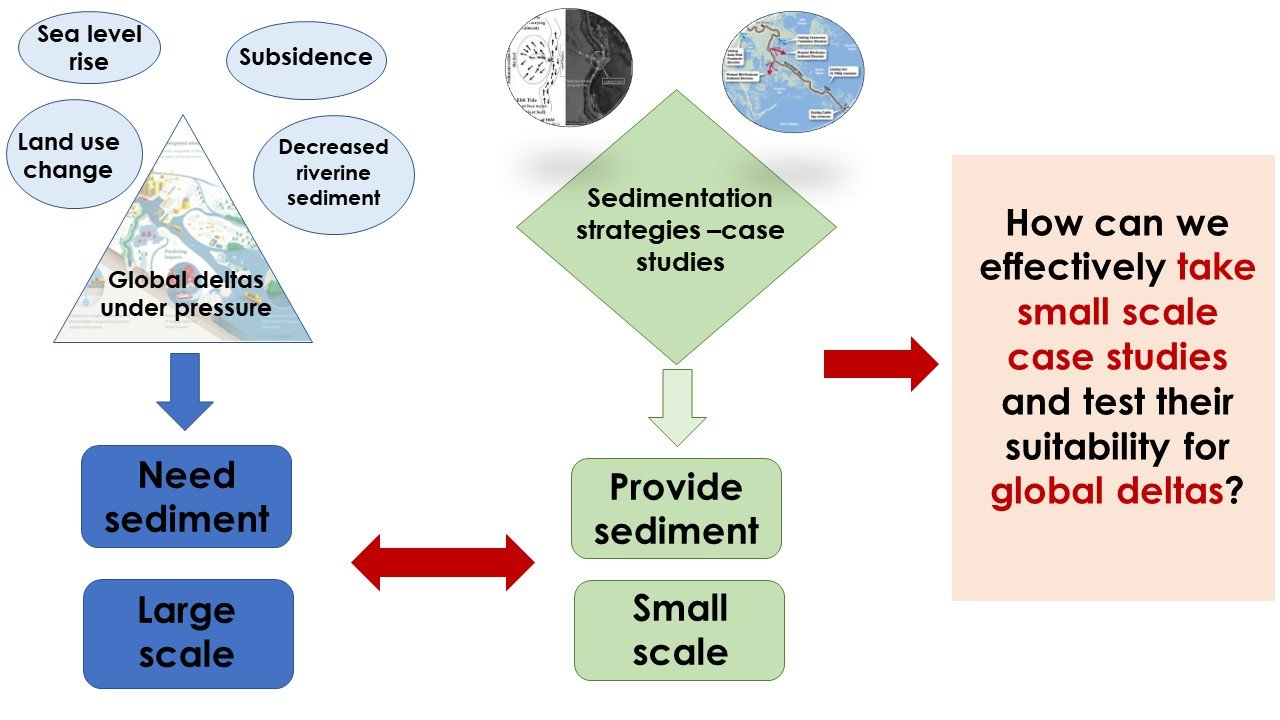Sedimentation enhancing strategies for river deltas: an interdisciplinary perspective
Sedimentation changes are one of the key issues faced by deltas around the world. Levees prevent sedimentation on delta plains, making them more vulnerable to sea-level rise. Accordingly, strategies to enhance sedimentation are crucial to maintain deltas and keep their populations safe.
About
This project runs from April 2020 until March 2021.
The main objective of the project is to create a comprehensive database of sedimentation strategies in deltas and to develop a tool for decision makers to assess the applicability of different sedimentation strategies for certain deltas. To do so we need to know the following: What are the current strategies for sedimentation in different deltas worldwide? What is their efficiency? What are the future adaptations we need to implement build more sustainable strategies?

To answer these questions, Master students Eline Sieben and Joey O’Dell carried out research on the subject, and the project team organized a workshop on December 7th 2020.
Research and workshop
Eline’s research focuses on analysing different case-studies from the Danube, Ganges-Brahmaputra, Mississippi and Rhine-Meuse delta, working towards an assessment of the applicability of existing sediment enhancing strategies for use in different deltas. Eline identified sedimentation enhancing strategies and reviewed the factors influencing the applicability of the strategies.
Joey O'Dell built a global database of flood-protection levees in deltas. Areas within levees are sheltered from floods and concomitant sedimentation, making them particularly vulnerable to long-term drowning from sea-level rise.
In the workshop, the project team presented existing sedimentation strategies for five deltas. The workshop also included a game to rate the efficiency of sedimentation for the Nile and Yangtze deltas. The strategies which were selected for the game were river sediment diversion, sediment trapping by planted vegetation, and tidal river management.
Project results
The project team will write a Wikipedia article about sedimentation enhancing strategies. This article will be updated based on new research.
The team is developing a multi-criteria analysis tool as a preliminary guideline for implementing sediment enhancing strategies and to provide an overview on benefits and drawbacks of existing strategies, in relation to new areas of application. The link to the KiesCompass page will be added here when development has finished.

A comprehensive global dataset to quantify where and how much sedimentation enhancing strategies will be necessary, and is under construction.
The workshop: important topics highlighted in the workshop are summarised in this document and include:
- Different strategies are needed in different parts of the delta.
- Identification of the important criteria that influence a sediment strategy’s implementation, including land-use loss, physical setting, land creation, environmental impacts, economic cost, governance and legal structure, stakeholder opinions, and long term sustainability of the strategy.
- The key limitations of strategy implementation include social-economic limitations, political will, physical limitations, deciding on system, communication, cost, river sediment availability.
- The future research priorities for developing the multicriteria tool include: local community needs and wants, political environment, how to incorporate urban areas where flood risk is the highest.
The end of the project will be marked by a review paper of the project research results. When the paper is available, it will be added here.
The team
The project team consists of the following staff members, as well as Master students Eline Sieben and Joey O'Dell:

